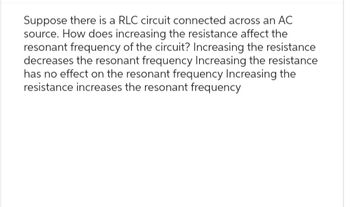
Structural Analysis
6th Edition
ISBN: 9781337630931
Author: KASSIMALI, Aslam.
Publisher: Cengage,
expand_more
expand_more
format_list_bulleted
Concept explainers
Question
thumb_up100%

Transcribed Image Text:Suppose there is a RLC circuit connected across an AC
source. How does increasing the resistance affect the
resonant frequency of the circuit? Increasing the resistance
decreases the resonant frequency Increasing the resistance
has no effect on the resonant frequency Increasing the
resistance increases the resonant frequency
Expert Solution
This question has been solved!
Explore an expertly crafted, step-by-step solution for a thorough understanding of key concepts.
Step by stepSolved in 3 steps

Knowledge Booster
Learn more about
Need a deep-dive on the concept behind this application? Look no further. Learn more about this topic, civil-engineering and related others by exploring similar questions and additional content below.Similar questions
- The Empire State Building in NYC is approximately 440 meters in height. The superstructure of the building is made of steel which means that energy will be transmitted through the buildings core at 1500 m/sec. If the building is being blasted and buffeted by a strong wind storm, at what frequency will the building sway in it's 1st mode of vibration. (Hint: think about what type of a resonator a building could be)arrow_forwardI need the answer as soon as possiblearrow_forwardSolve without aiarrow_forward
- Please don't use chat gbt will upvotearrow_forwardCurrent Attempt in Progress X Incorrect Calculate the moment (positive if counterclockwise, negative if clockwise) of the 250-N force on the handle of the monkey wrench about the center of the bolt. 30 mm Answer: M = i 41.61 215 mm 250 N 32° N•marrow_forwardThe 40 ft. long steel rails on the train track are placed such that there is small gap, 8, between them to allow for thermal expansion. A 100 Ib/yard a rail has a cross-sectional area of 9.80 in?. The steel used has the following material properties: E = 29,000 ksi 6.6 HE/ F (a) What is the size of gap, 8, required so that the rails just touch one another when the temperature increases from -20°F to 100°F. (b) Given the gap you found in (a), what would the axial force in the rails be if the temperature rises to 130°F.arrow_forward
- I need the answer at 20 minute .arrow_forward9. What is the direction of the induced current in each scenario below? Acceptable answers are: Clockwise, Counterclockwise, and no induced current. In scenario C, the loop does not cross the wire. In scenario F, the magnetic field only exists in the region outlined by the dashed lines creating a square. A. B. Loop Loop A B C Loop C. D. D E. F. Magnet moving down Loop E Magnet moving S down I Loop Bexternal Area of loop decreasing Current I decreasing in magnitude F I Loop moving down O Loop Be external Angle theta starting at 90 and decreasing to 0 degreesarrow_forward
arrow_back_ios
arrow_forward_ios
Recommended textbooks for you

 Structural Analysis (10th Edition)Civil EngineeringISBN:9780134610672Author:Russell C. HibbelerPublisher:PEARSON
Structural Analysis (10th Edition)Civil EngineeringISBN:9780134610672Author:Russell C. HibbelerPublisher:PEARSON Principles of Foundation Engineering (MindTap Cou...Civil EngineeringISBN:9781337705028Author:Braja M. Das, Nagaratnam SivakuganPublisher:Cengage Learning
Principles of Foundation Engineering (MindTap Cou...Civil EngineeringISBN:9781337705028Author:Braja M. Das, Nagaratnam SivakuganPublisher:Cengage Learning Fundamentals of Structural AnalysisCivil EngineeringISBN:9780073398006Author:Kenneth M. Leet Emeritus, Chia-Ming Uang, Joel LanningPublisher:McGraw-Hill Education
Fundamentals of Structural AnalysisCivil EngineeringISBN:9780073398006Author:Kenneth M. Leet Emeritus, Chia-Ming Uang, Joel LanningPublisher:McGraw-Hill Education
 Traffic and Highway EngineeringCivil EngineeringISBN:9781305156241Author:Garber, Nicholas J.Publisher:Cengage Learning
Traffic and Highway EngineeringCivil EngineeringISBN:9781305156241Author:Garber, Nicholas J.Publisher:Cengage Learning


Structural Analysis (10th Edition)
Civil Engineering
ISBN:9780134610672
Author:Russell C. Hibbeler
Publisher:PEARSON

Principles of Foundation Engineering (MindTap Cou...
Civil Engineering
ISBN:9781337705028
Author:Braja M. Das, Nagaratnam Sivakugan
Publisher:Cengage Learning

Fundamentals of Structural Analysis
Civil Engineering
ISBN:9780073398006
Author:Kenneth M. Leet Emeritus, Chia-Ming Uang, Joel Lanning
Publisher:McGraw-Hill Education


Traffic and Highway Engineering
Civil Engineering
ISBN:9781305156241
Author:Garber, Nicholas J.
Publisher:Cengage Learning